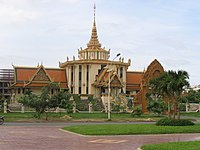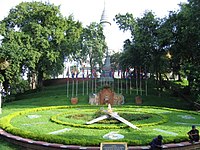The capital of the Kingdom of Cambodia, Phnom Penh, is located at the confluence of three rivers - the Mekong, the Bassac and Tonle Sap. The city is divided into three sections - the north, an attractive residential area; the south or the French part of the city with its ministries, banks and colonial houses; and the centre or the heart with its narrow lanes, markets, foods stalls and shops.
Over the past four years, the city has undergone tremendous changes - businesses are springing up constantly and tourism is once again booming. Cambodia has one of the most liberal investment laws to further boost managed to retain its charm and character - cyclos that weave through traffic with ease, broad boulevards, old colonial buildings, parks and green spaces that reminds one of the country's French heritage, and above all its people who always have a smile for you.
| A stone's throw away from the Tonle Sap is the royal Palace built on the site of the Banteay Kev, a citadel built in 1813. The Palace grounds contain several buildings: the Throne Room of Prasat Tevea Vinichhay which is used for the coronation of kings, official receptions and traditional ceremonies; the Chan Chhaya Pavilion which is a venue for dance performances; the king's official residence called the Khemarin; the Napoleon Pavilion and the spectacular Silver Pagoda. This pagoda is worth exploring. It owes its name to the 5,000 silver tiles weighing 1kg each which cover the entire floor. | |
| The emerald Buddha sits on a pedestal high atop the dias. In front of the dias stands a life-size Buddha made of solid gold and weighs 75kg. It is decked with precious gems including diamonds, the largest of which is 25 carats. Also on display at the sides are the coronation apparel and numerous miniature Buddha in gold and silver. The walls surrounding the compound which is the oldest part of the palace, are covered with frescos depicting scenes from the Khmer version of the Ramayana. | |
INDEPENDENCE MONUMENT: |
| ||||
| |
|
| NATIONAL MUSEUM: The NATIONAL MUSEUM of Cambodia is housed in a graceful terracotta structure of traditional design (built 1917-20) just north of the Royal Palace. It is open Tuesday to Sunday from 8 to 11 am and from 2 to 5 pm; entry is $3. Photography is prohibited inside. The School of Fine Arts (École des Beaux-arts) has its headquarters in a structure behind the main building. See more...
|
| | WAT PHNOM: You may also want to check out WAT PHNOM which sits on a tree covered hill about 30m high in the northeast of the city. It is said that the first pagoda was built in 1373 to house four statues of the Buddha deposited here by the Mekong river. It was discovered by a woman named Penh. Thus, the name Phnom Penh, the hill of Penh. The people believe that this temple is powerful in that anyone who makes a wish will have it granted. It is not surprising to see many people coming here to pray for protection or healing. Many bring lotus flowers as offerings for prayers answered. |
At the bottom of the hill is a small zoo, but its most endearing residents, the monkeys, live free in the trees. See more...
| TUOL SLENG MUSEUM: In 1975,Tuol Svay Prey High School was taken over by Pol Pot's security force and turned into a prison known as Security Prison 21 (S-21) It soon became the largest such centre of detention and torture in the country. Over 17,000 people held at S-21 were taken to the extermination camp at Choeung Ek to be executed; detainees who die during torture were buried in mass graves in the prison grounds. See more... | |
CHEUNG EK KILLING FIELD:
Between 1975 and 1978,aabout 17,000 men, women, children and infants (including nine westerners), detained and tortured at S-21 prison (now Tuol Sleng Museum), were transported to the extermination to death to avoid wasting precious bullets. See more...
| NEW CENTRAL MARKET: A visit to the markets and market halls is a must as they give an opportunity to be acquainted with the country's local produce and also to buy textiles, antiques, gold and silver jewellery. The four wings of the yellow coloured Central Market are teeming with numerous stalls selling gold and silver jewellery, antique coins, clothing, clocks, flowers, food, fabrics, shoes and luggage. | |
TUOL TOM PONG MARKET:
For some good paintings or if you prefer antiques, head fro the Tuol Tom Poong Market also known as the Russian Market. A word of caution though: you need to sharpen your bargaining skills as the prices here can be outrageously high.



 The monument was built in 1958 to symbolise the independence that Cambodia gained from France in 1953. The French fully abandonned their interests in Indochina following defeat by the Vietnamese at the battle of Dien Bien Phu in May 1954. Independence is marked in Cambodia on the 9th November. The monument has a unique and peculiar style and doubles as a memorial to Cambodian patriots who died for their country.
The monument was built in 1958 to symbolise the independence that Cambodia gained from France in 1953. The French fully abandonned their interests in Indochina following defeat by the Vietnamese at the battle of Dien Bien Phu in May 1954. Independence is marked in Cambodia on the 9th November. The monument has a unique and peculiar style and doubles as a memorial to Cambodian patriots who died for their country.












0 comments:
Post a Comment